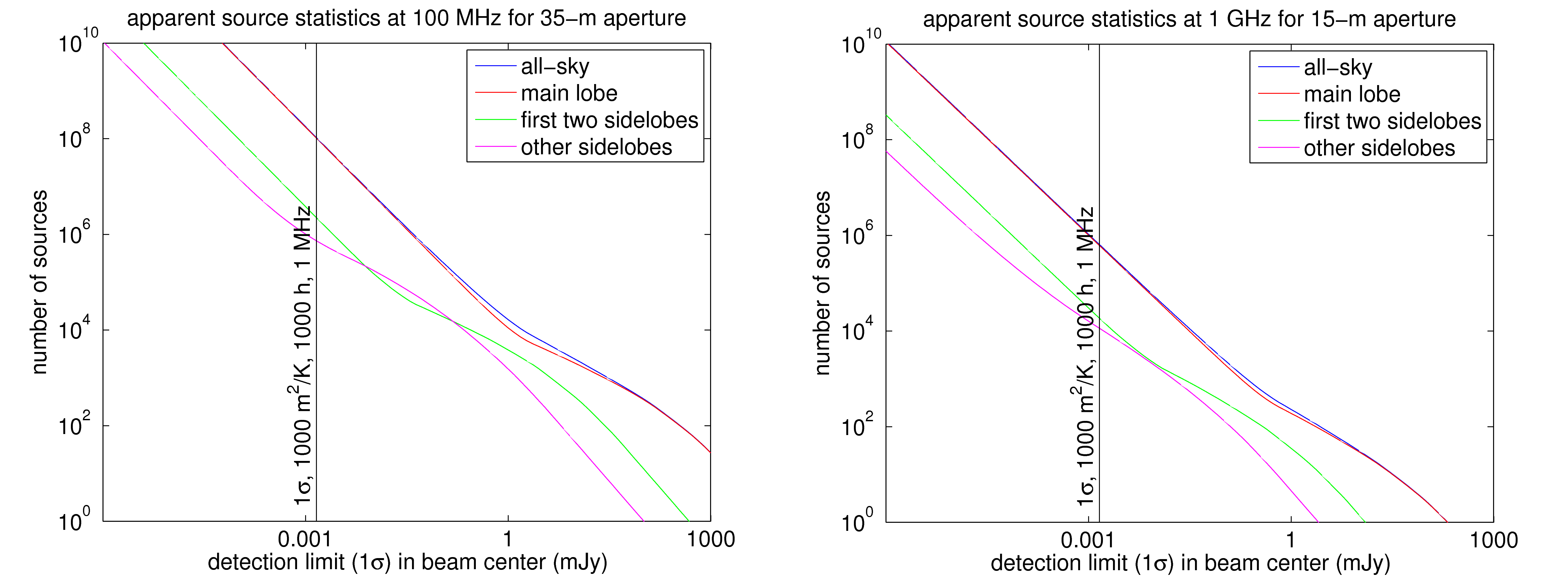Daily Image
12-12-2014Calibratability Fundamentals (2): Impact of observing frequency on apparent source statistics
| Submitter: | Stefan Wijnholds |
| Description: | In our daily image of October 31, we started an investigation of the number of sources that will be visible anywhere in the field-of-view of a 15-m filled aperture at 1 GHz (shown in the right panel for convenience). We argued that, as telescope sensitivity increases, the number of sources may grow so large that their cumulative sidelobes may increase the image noise to a level that nullifies the (very expensive) nominal sensitivity of the telescope, in particular the SKA. Since ASTRON has a particular interest in the Low-Frequency Aperture Array (LFAA) for the SKA, we now present the results for a 35-m filled aperture at 100 MHz (left panel). The curves in these plots indicate the total number of sources brighter than a given apparent flux. This is shown for various lobes of the primary beam pattern, i.e. the LFAA station beam on the left, and a typical SKA dish beam on the right. Although the shape of the curves, as well as the distribution of sources over various parts of the primary beam, are very similar for both cases, the 35-m aperture at 100 MHz detects about a hundred times more sources than the 15-m aperture at 1 GHz. This is caused by two effects. Firstly, the primary beam size of the 35-m aperture at 100 MHz is about 20 times larger than that of the 15-m aperture at 1 GHz. The second effect is, that the synchrotron spectrum of most continuum sources is about 7 times brighter at 100 MHz than at 1 GHz. Although the second effect is damped a little bit by the decrease in telescope sensitivity due to increasing sky noise towards lower frequencies, the net result, as shown in these plots, is that the LFAA system is likely to detect about a hundred times more sources than the SKA-dish system, in an observation with the same integration time and bandwidth. It is interesting to note that the ability to detect about 100 million sources in a single observation, implies that the SKA-low system will be capable of detecting virtually every galaxy in the universe(*). Of course that would require a resolution of 1", i.e. baselines up to 600km. In a future daily image, we will show that, to achieve this lofty goal, we have to think carefully about the design of our instrument to keep the PSF(**) sidelobe level as low as possible. Almost certainly this will require a station configuration that is different from the one currently proposed for the LFAA. (*) Based on an estimate of a total of 100 billion galaxies. (**) Point Spread Function |
| Copyright: | ASTRON |
| Tweet |  |
